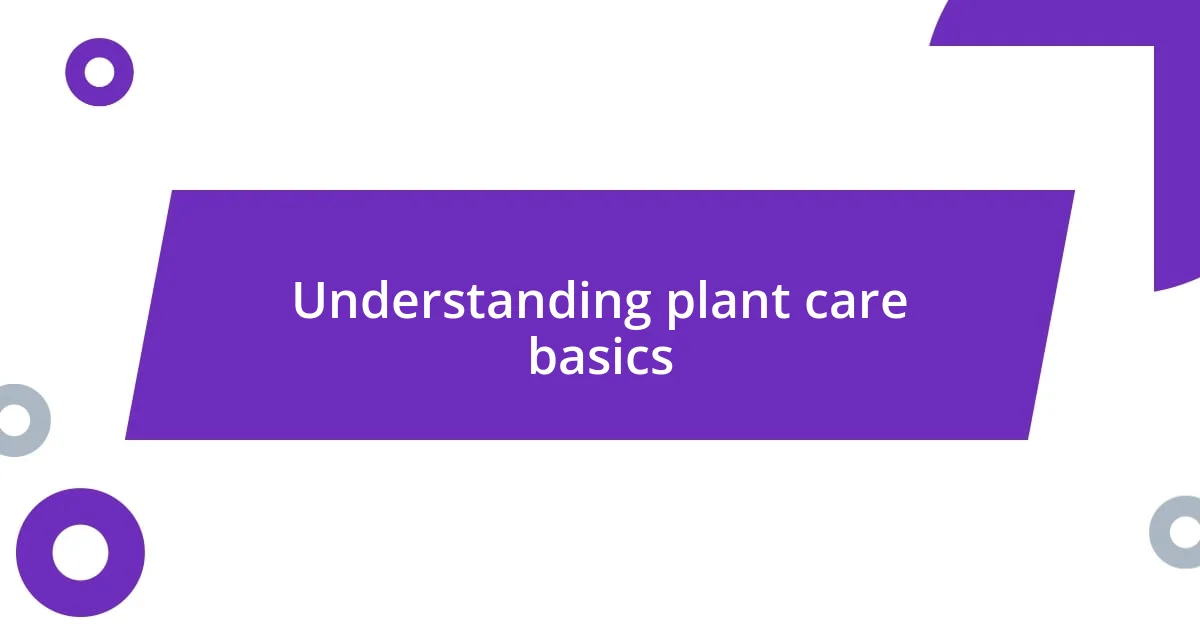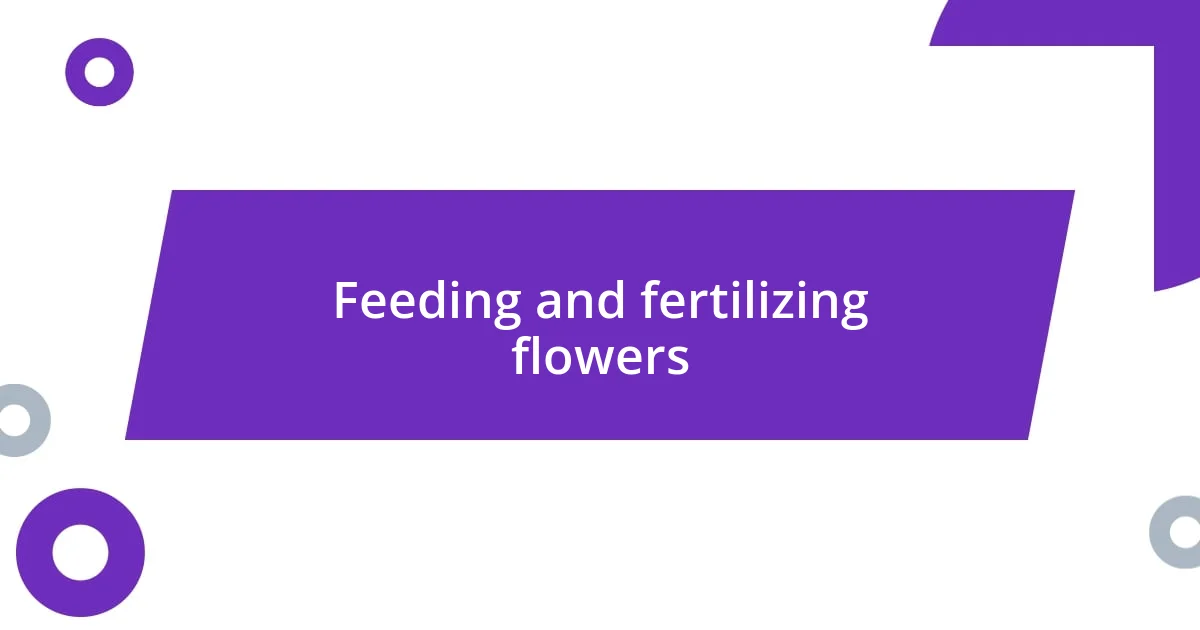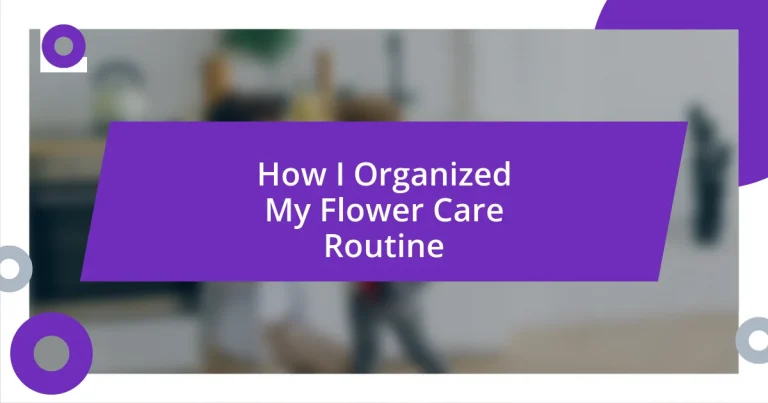Key takeaways:
- Understanding specific light, soil, and watering needs is crucial for successful plant care, as it directly affects plant health and growth.
- Choosing the right flowers based on climate, bloom times, and maintenance level can greatly enhance the beauty and longevity of a garden.
- Keeping a care journal helps document experiences and insights, fostering a deeper connection to gardening and improving care practices over time.

Understanding plant care basics
Understanding the fundamentals of plant care is essential for nurturing a thriving garden. For instance, I remember when I first got my hands on a beautiful snake plant. It was so exciting, but I quickly learned that overwatering was an easy trap to fall into. Have you ever felt that pang of anxiety when you think about whether you’ve drench your plants or not?
Light requirements are another crucial element. I once placed my beloved peace lily in what I thought was a sunny spot, only to find it drooping sadly a few days later. This experience taught me that not all plants thrive in the same conditions. How often do we overlook the specific needs of our green companions?
I’ve also discovered the importance of knowing the right soil and potting needs. Initially, I didn’t understand that the type of soil can dramatically affect moisture levels and nutrient access. When I switched to a well-draining mix for my succulents, they flourished in ways I had never anticipated. Isn’t it fascinating how something as simple as the right soil can transform your plant’s health?

Choosing the right flowers
When it comes to choosing the right flowers, I always start by considering the climate and environment of my garden. For instance, I made the mistake of planting sunflowers in a shaded area—let me tell you, it was a major flop! They stood there, looking sad and stunted, reminding me that some flowers just crave that bright sunshine to thrive. Have you ever made a choice that felt right but was completely off the mark?
Furthermore, understanding bloom times is essential. One time, I planted a mix of spring and summer flowers, thinking they would create a continuous spectacle of color. Unfortunately, I ended up with a vibrant show for just a few weeks, followed by a long wait for the summer blooms to come along. It was a lesson learned: timing can make or break the aesthetic appeal of your garden. How often do we consider how our selections interact with each other over the seasons?
Lastly, the maintenance level is another key factor I contemplate. For example, I fell in love with peonies, drawn to their lush beauty, but I didn’t realize they required diligent care and protection from pests. Now, I choose flowers like zinnias, which are not only stunning but also quite resilient—perfect for a busy weekend warrior like myself. Have you ever wished for low-maintenance beauty in your garden?
| Flower Type | Sunlight Requirements |
|---|---|
| Sunflower | Full sun |
| Peace Lily | Partial shade |
| Zinnia | Full sun |
| Peony | Full sun to partial shade |

Assessing environmental conditions
When I first embraced gardening, I quickly realized that environmental conditions could significantly sway my flower care success. I vividly remember standing outside, scrutinizing the sunlight patterns in my yard. That day, shadows danced across my roses, and it hit me—choosing the right location in relation to sunlight is everything. Understanding which areas of your garden receive direct sunlight, partial shade, or complete shade can completely change the vitality of your flowers.
- Observe sun patterns throughout the day to identify the best spots for different flowers.
- Consider wind exposure; I once lost some delicate blooms to unexpected gusts; now I keep them sheltered.
- Take note of soil drainage; wet spots can drown even the hardiest of plants, as I learned the hard way.
Temperature fluctuations can also take a toll on your garden. I fondly recall a balmy spring day that allowed my tulips to burst forth with color, only for a sudden frost to ruin the show. Now, I’m much more attentive to seasonal changes, ensuring I protect my flowers when needed. When assessing your environment, consider how resilient your plants are to such shifts. It’s this awareness that brings out the best in your garden.

Creating a watering schedule
Creating a watering schedule is essential for keeping my flowers lively and vibrant. I remember the first summer I tried to manage my bouquet of blooms: I watered them daily, thinking that more was better. Spoiler alert: I ended up drowning my marigolds, and I now realize that overwatering can be just as damaging as neglect.
After much trial and error, I learned the value of checking the moisture level in the soil. I often dig my finger into the dirt, about an inch deep, before watering. If it feels dry, I give them a drink, and if it’s still damp, I resist the urge. Have you ever experienced the surprise of seeing a plant perk up right after watering? That little moment can be so rewarding!
Now, I also take seasonal changes into account. As the temperatures rise, my flowers drink more, and I adjust my schedule accordingly—sometimes even watering in the early morning to prevent evaporation. I still recall a particularly hot July when I forgot to change my routine, and my beloved daisies started drooping. Seeing them bounce back after a little extra care felt like magic. How often do we really tune into the needs of our plants?

Feeding and fertilizing flowers
Feeding and fertilizing flowers can seem daunting at first, but I believe it’s one of the most rewarding parts of gardening. A few seasons back, I experimented with different fertilizers, and I still vividly remember the moment my peonies exploded with blooms after I applied a balanced, slow-release fertilizer. It’s fascinating how the right nutrient mix can transform your flowers, isn’t it? I learned to read labels carefully, selecting something that matched the specific needs of my blooms.
In my experience, timing plays a crucial role in how effectively flowers absorb nutrients. I typically feed my plants in the spring when they’re just waking up from their winter slumber, eager for a boost. There’s nothing quite like strolling through the garden and witnessing the vibrant colors sprouting, all thanks to that timely feeding. I still chuckle at the time I forgot to fertilize for an entire season, and my garden looked a bit lackluster in comparison—definitely a lesson learned!
Additionally, not all flowers are created equal when it comes to their nutrient needs. For instance, my sunflowers thrive on high phosphorus levels, whereas my orchids prefer a more delicate touch with diluted liquid fertilizers. It’s a little like cooking: knowing which ingredients enhance each recipe is key! Have you ever glanced at a wilted flower and wondered what it needed? Trust me, a little patience and observation can unveil the secret to vibrant blooms.

Managing pests and diseases
Managing pests and diseases is an ongoing challenge that requires vigilance and a bit of intuition. One summer, I encountered aphids on my roses, and I remember the sinking feeling as I spotted those tiny green invaders munching away at my blooms. It prompted me to research natural remedies, and I discovered that a simple spray of diluted dish soap and water could deter those pesky pests without harming the plants. Have you ever found solace in organic solutions when chemical options felt too harsh?
As I became more acquainted with my garden, I learned to recognize the signs of distress, like spots on leaves or wilting flowers. One particularly rainy season, my daisies caught a case of powdery mildew. I felt a mix of frustration and urgency; I knew I had to act fast! I decided to prune the affected areas and apply a fungicidal solution. It’s incredible how a little proactive care can reshape the health of your flowers—have you noticed how a few small changes can lead to significant improvements?
Regular inspections became part of my routine, almost like a morning ritual. I’d stroll through my flower beds with a cup of coffee, scanning for any signs of trouble. It’s a peaceful practice, allowing me to connect with my plants on a deeper level. When I spot a potential issue early, I feel a surge of confidence—like I’m truly nurturing my garden rather than merely observing it. How often do we take the time to really look, to engage with what we’ve cultivated? I believe those moments of connection can be transformative for both the gardener and the garden.

Keeping a care journal
Keeping a care journal has been a game-changer in my flower care routine. Initially, I started jotting down notes on a whim, but over time, it evolved into a treasure trove of insights. I remember the excitement I felt when I landed on a particular fertilization schedule that made my marigolds burst forth with color. Seeing those notes transform into tangible results has been incredibly gratifying.
I often find myself flipping through the pages, reliving those little victories and lessons learned. One entry stands out: an instance of stubborn petunias that just wouldn’t bloom. I chronicled every step I took, from watering practices to sunlight exposure, eventually leading me to discover they preferred more shade. Can you imagine the satisfaction of solving a plant’s mystery just by reflecting on what you’ve recorded?
The emotional aspect of keeping this journal is profound. It’s not merely a record-keeping tool; it’s a place where I document my journey, my frustrations, and my joys. I’ve filled pages with sketches of my garden layout and even felt the need to write heartfelt notes on the days I lost a beloved plant. It can feel therapeutic, don’t you think? I’ve learned that when we reflect on our experiences, we cultivate not just flowers but also a deeper connection to the very act of gardening itself.














